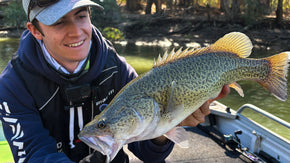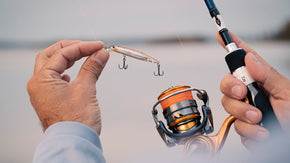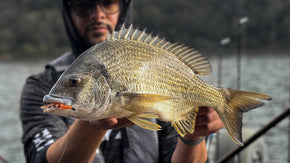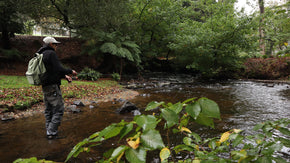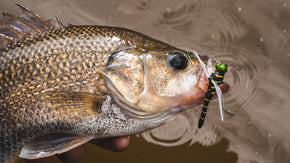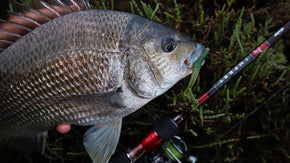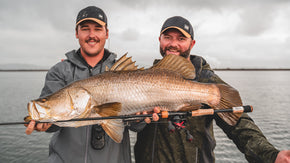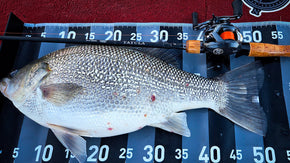Posted 17th April 2025
Must Have Lures for Impoundment Australian Bass


By Charles West
Fishing for Australian bass in dams and lakes can be an exhilarating experience, especially for beginners. To improve your chances of a successful catch, it's crucial to have the right lures in your tackle box. Here are my top lures when targeting Australian bass in our lakes and dams.
Spinnerbaits
Spinnerbaits are excellent for covering large areas of water quickly. These lures feature spinning blades that create vibrations and flashes, attracting bass from a distance. Use spinnerbaits around structures such as, submerged timber, weed beds, and rocky points to create reaction strikes from bass. There are variety of retrieves to use with a spinnerbait, with a slow constant retrieve, often punctuated by a pause, is the go-to in most cases.
Lipless Crankbaits
Lipless crankbaits are sinking lures that produce a wobbling action with most having ball bearings in them to create noise. They are ideal for fishing in deeper and shallow waters and can be used throughout the year. Lipless crankbaits are particularly effective in dams and lakes with steep drop-offs, submerged timber, weed beds and rocky points. Retrieve them with a constant wind after sinking them to the desired depth. You can vary up the speed of the retrieve to get that reaction strike.
Topwater Lures
Topwater poppers are surface lures that create a splash and popping sound when retrieved, imitating struggling prey. These lures are perfect for early morning or late evening fishing when bass are actively feeding near the surface. Use them around shallow areas with vegetation, lily pads, or overhanging trees for explosive topwater strikes. Unfortunately, these lures won’t work on all lakes as some waterways don’t have much of a surface bite due to deep water living bait sources (e.g. boney bream).
Jerkbaits
Jerkbaits are slender, suspending lures that dart side-to-side when jerked or twitched. They resemble an injured baitfish and are ideal for clear water conditions and can be used year-round but them come into their own in winter when the bass slow down and want a lure right in their face. Fish jerkbaits around weed edges, submerged weed beds, overhang trees/ brushes and around standing timber. Vary your retrieve with pauses to mimic the erratic movement of a wounded fish with a ‘twitch-twitch-pause’ retrieve. Long pauses are great as a bass will come up behind the lure and suspend there until you move the lure again.
Paddle Tail Soft Plastic
Soft plastic paddle tails are realistic-looking lures that mimic the swimming action of baitfish. They are effective in both clear and dirty waters and can be used in various fishing conditions. Cast them near weed edges, submerged weed beds, timber, and rocky areas and deep points and flats. These lures work well with a slow, steady retrieve, imitating a casually swimming bait fish. The go-to size for these types ‘OG’ plastics are 2-4” long, with matching the length to the size of the lake’s baitfish the way to go. These lures will require a weighted jighead to rig the soft plastic on. Jigheads come in all different sizes and weights. A 1/8 to 1/2 ounce with a #1 to #3/0 size hook is standard jigheads for rigging bass soft plastics.
Chatterbaits
Chatterbaits, also known as bladed jigs or vibration jigs, combine the action of a jig with the flash and vibration of a spinnerbait. They are particularly effective in dirty and clear waters and are best fished around structures such as weed beds, submerged timber, rocky points and deep and shallow points and flats. Vary your retrieve speed to find the most effective presentation on the day. The retrieves consist of a constant wind, hopping and returning to the bottom or winding slowly for a few winds them stop and return to the bottom again. Most of the time you will be fishing them close to the bottom trying to mimic a crayfish. You can also add soft plastics to the back of them to change their appearance.
Crankbaits
The OG when bass on lures became a thing in Australia many decades ago, lake anglers have really taken to crankbaits in the last five to ten years. Available in a variety of sizes and running depths a 2-3” crank is an essential for any impoundment bass angler. An assortment of crankbaits that run between 2-20 feet will have you covered for most scenarios and locations. Flooded timber, weed lines, flats, points, and drop offs are all prime crankbait areas to fish. Retrieves can be varied, with a slow roll (constant retrieve) the most effective technique, and the best place to start when trying to crack the pattern. A great searching lure, a crankbait is an excellent lure to trying in a new location.
Spoons (metal jigs)
Metal jigs also known as spoons are flat oval-shaped or flat and slim lures that mimic a fleeing or dying bait fish. Spoons are generally metal but at times can be made from hard plastic too. There are a lot of colours and different weights too. Spoons have a great wobble and shine to them, with their chromed/silver sides flashing in the light like a baitfish. These lures can be retrieved from hopping, vertical jigging to casting and continuous winding. Best places to use them is on flats, drop offs and points. These lures can cover a lot of ground due to their weight and ability to cast them a long way.
Conclusion
Having the right lures in your tackle box is essential for a successful bass fishing experience in dams and lakes. Each of these lures offers unique advantages and can be used in various fishing conditions. By understanding where and when to use them, you'll increase your chances of landing that prized Australian bass. Keep casting , keep believing.










